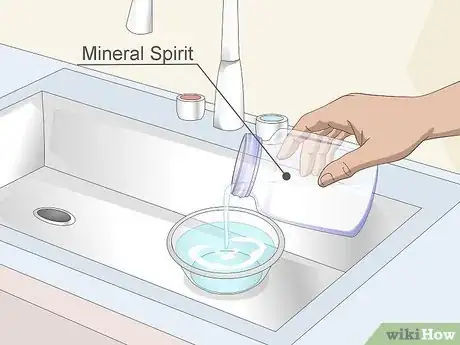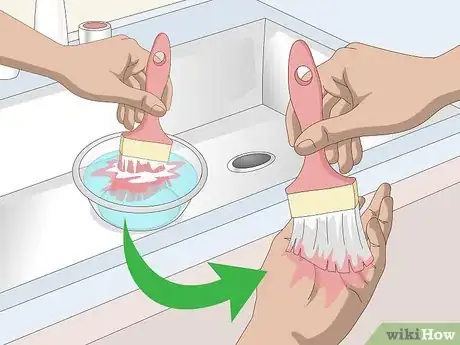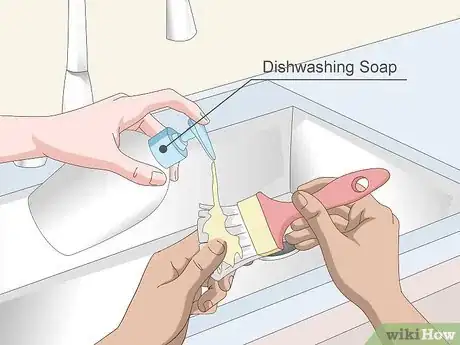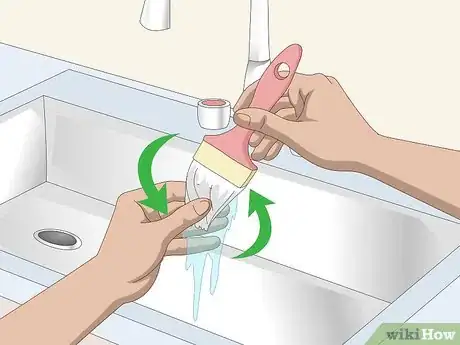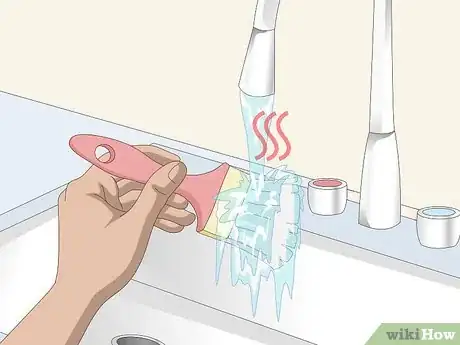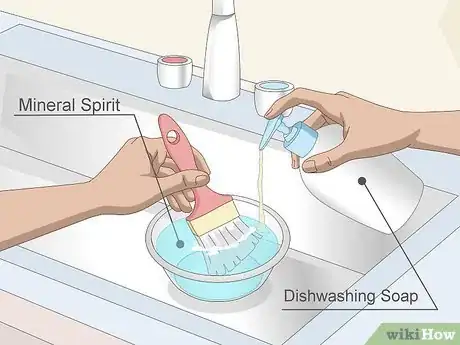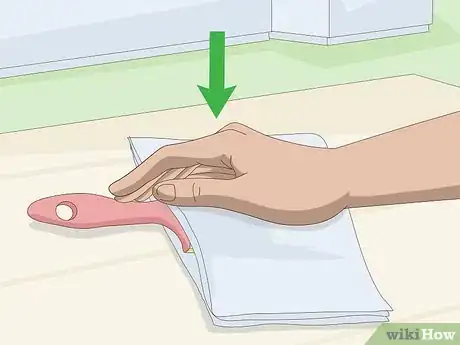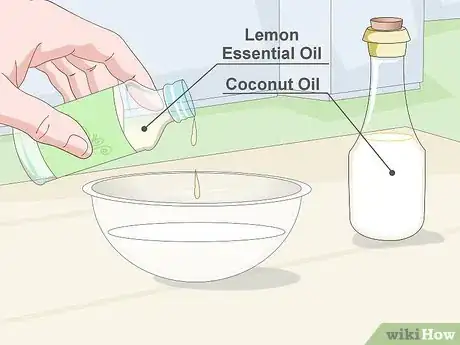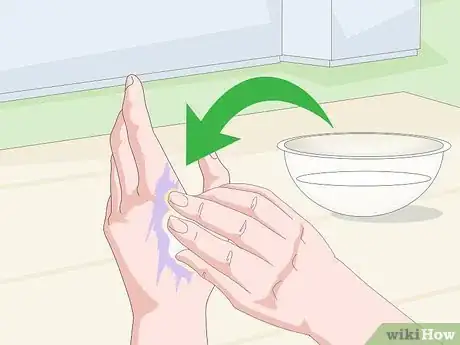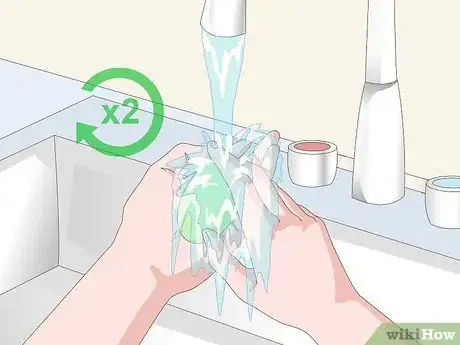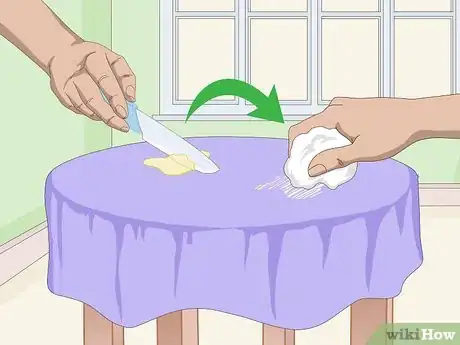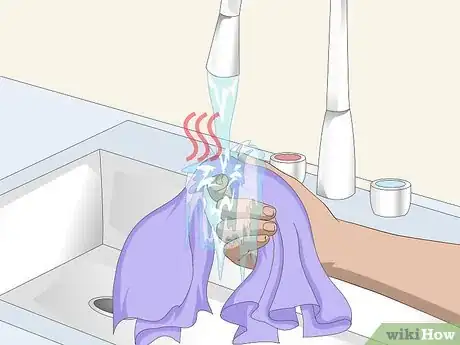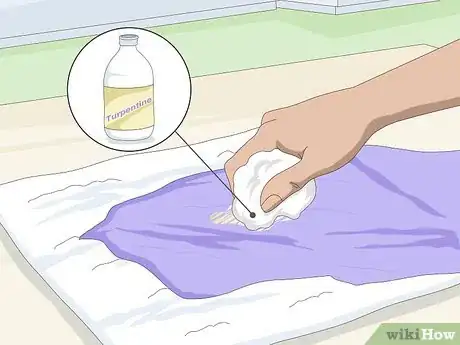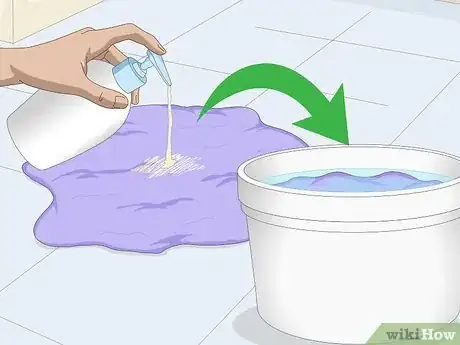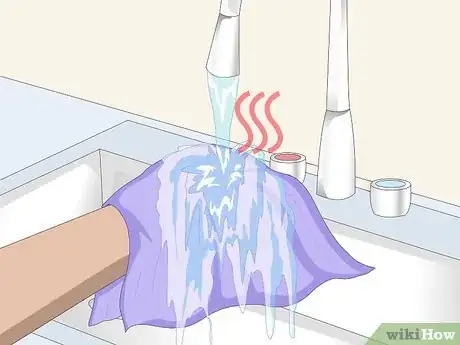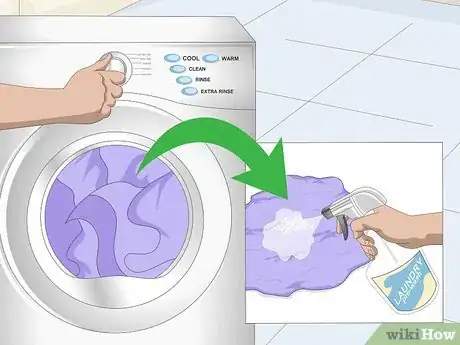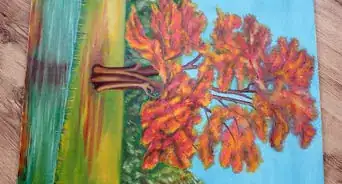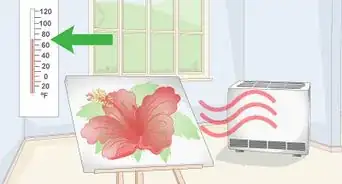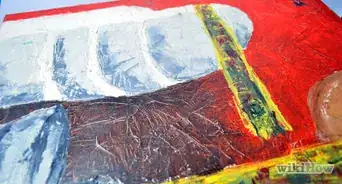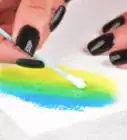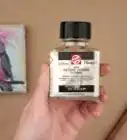This article was co-authored by Renée Plevy. Renée Plevy is an Internationally Acclaimed Portrait Artist from New York/Palm Beach who has painted The Grand Dames of Palm Beach and various celebrities and community leaders. With over 50 years of experience, Renée specializes in painting realistically in oil and capturing the soul of the person. She has studied under internationally renowned portrait artists John Howard Sanden, David Leffel, Robert Beverly Hale, Clyde Smith, and Leonid Gervits. Renée is featured in over 68 shows and galleries including a one-woman museum show at the Paterson Museum. She has garnered numerous awards including “Artist of the Year” from The Bloomfield Art League and First Prize from the Boca Raton Museum Artist’s Guild. Renée has even painted a portrait of celebrity, Vanilla Ice. She also teaches at the Boca Raton Museum Art School - formerly at SVA in Manhattan.
This article has been viewed 103,671 times.
Whether you're painting your living room or working on a landscape to hang over the mantle, oil-based paint offers a rich, smooth look that's hard to beat. The problem with it, though, is that it's usually much more difficult to clean up that water-based paints. However, if you know the right products and procedures to use, you can make cleaning up oil paints much easier. Using products that can cut through the oil is the key, so whether you want to remove the paint from your brushes, your skin, or fabric, you need a cleansing agent that will break it down so you can rinse it away.
Things You Should Know
- Use mineral spirits and dish soap to clean oil-based paint off paintbrushes.
- Use oil, like coconut or olive oil, to remove oil-based paint from your skin.
- Blot oil-based paint stains on fabric with turpentine to remove them.
Steps
Removing Oil-Based Paint from Brushes
-
1Add mineral spirits to a small non-plastic bowl. To help thin the oil paint on your brushes, you’ll need a paint solvent. Odorless mineral spirits work well, so fill a small glass or ceramic bowl with a small amount of the liquid and place it in the sink where you plan to clean the brushes.[1]
- You can also use turpentine to remove oil-based paint from brushes. However, it has an extremely strong odor so it’s important to ensure that you’re working in a well-ventilated area.[2]
-
2Dip the brush in the mineral spirits and run back forth on your hand. When you’re ready to clean the brush, submerge it in the bowl of mineral spirits to ensure that all of the dirty bristles are coated. Next, rub the brush back and forth against your hand to work the mineral spirits into the bristles.[3]
- Make sure that you rub both sides of the brush over your hand to ensure that you work the minerals spirits into all of the oil-based paint stains.
Advertisement -
3Pour some dishwashing soap on the brush and rub it in. After you’ve worked the minerals spirits into the brush, squeeze a small amount of dishwashing liquid soap onto the bristles. Use your fingers to vigorously rub it into the brush.[4]
- Any dishwashing liquid soap that is marketed as being able to cut through grease will work for cleaning your brushes.
- The precise amount of dishwashing soap that you’ll need will depend on how large the brush is and how dirty they are. Aim for a 1- to 2-inch (25- to 50-mm) dollop of the liquid.
-
4Squeeze out the liquid from the brush. Once you’ve worked the dishwashing liquid into the brush, use your fingers to carefully squeeze all of the excess liquid from the bristles. Try to remove as much of the paint, mineral spirits, and dishwashing soap residue from the brush as possible as you wring it out.[5]
-
5Rinse the brush under hot water. After you’ve removed as much of the liquid from the brush as you can, turn the water on in the sink and let it run for 30 seconds or so until it’s hot. Run the brush under the water to rinse it clean, and squeeze it again to ensure that you remove all of the lingering residue.[6]
- If the brush is extremely dirty or the paint stains are old, you may need to repeat all of these steps two or more times to remove all of the paint.
-
6Dip the brush into the mineral spirits and add dishwashing soap again. When you’ve removed all of the paint that you can from the brush, submerge it in the mineral spirits again. Next, squirt a pea-size amount of dishwashing liquid on it and work both into the spirits and soap into the bristles with your fingers.[7]
- After you’ve worked the cleansers into the brush this time, do not rinse them out.
-
7Place the brush on folded paper towel and squeeze out the excess liquid. With the minerals spirits and dishwashing liquid still on the brush, set it down on a folded piece of paper towel. Squeeze the paper towel around the bristles to remove the any remaining liquid. Leave the brush out to air dry completely.[8]
- Leaving the film of minerals spirits and dishwashing liquid on the brush to dry will help keep the bristles soft so it’s like new when you use it the next time.
Washing Oil-Based Paint Off Your Skin
-
1Combine lemon essential oil and coconut oil. To create a cleanser to remove the paint from your skin, add a small scoop of coconut oil and 2 to 3 drops of lemon essential oil to a bowl. Mix the ingredients well to ensure that they’re thoroughly combined.[9]
- You can use any type of oil, such as olive oil, jojoba oil, or canola oil, to help break down the oil-based paint. Coconut oil usually work best because it is solid at room temperature so it won’t make as big a mess as you rub it into your skin.
- The amount of coconut oil that you’ll need depends on how much paint is on your skin. Start with a small amount and add more if the paint isn’t coming off.
- Adding the lemon essential oil is optional. However, it is believed to be an extremely effective cleanser so it may help the paint come off more easily.
-
2Rub the mixture all over the affected skin. After you’ve mixed the coconut oil and lemon essential oil, use your fingers to apply the mixture to the areas where the paint has stained your skin. Massage the coconut oil into your skin until the paint breaks down and comes off.[10]
- If all of the paint isn’t coming off, add a little more coconut oil to your skin to help break down the remaining paint.
-
3Wash your skin with soap and water. After you’ve removed the paint with the coconut oil, use your usual hand or body soap and water to clean the residue from your skin. Pat your skin dry, and follow up with a moisturizing lotion to keep your skin from drying out.[11]
- If you have a lot of paint on your skin, you may need to repeat the cleaning process two or more times to remove all of it.
Getting Oil-Based Paint Stains Out Of Fabric
-
1Scrape off the paint and blot the fabric. As soon as you notice that you’ve gotten oil-based paint on fabric, use a utility knife, plastic knife, or even a piece of sturdy cardboard to scrape it off. Next, blot the paint stain with a clean white cloth or rag to absorb any excess moisture from the paint stain.[12]
- It’s important to use a white cloth to blot the paint stain to ensure that no dye transfer from the cloth to the fabric that you’re cleaning.
-
2Rinse the stain with water. After you’ve scraped off and blotted the paint from the fabric, use warm or hot water to rinse the area. You can squeeze the excess moisture from the fabric afterward, but don’t allow it to dry completely.[13]
- Check the care instructions for the fabric that you’re cleaning. Use the hottest water appropriate to rinse the paint stain.
-
3Blot the affected area with turpentine. Once you’ve rinsed the fabric, place it on a clean white towel. Use a clean white cloth to blot the area with turpentine to help lift the paint stain from the fabric.[14]
- Turpentine may cause some fabrics to fade. Test a small, inconspicuous area of the fabric to ensure that it won’t be damaged.
- If you don’t want to use turpentine to blot the stain, you can use minerals spirits.
- You may need to blot the stain with turpentine several times to remove all of the paint.
-
4Apply dishwashing liquid to the stain and allow it to sit overnight. After you’ve blotted the stain with the turpentine, rub a small amount of dishwashing liquid over the remaining stain. Next, place the fabric is a tub or bucket filled with warm water and allow it to soak overnight.[15]
- Use a dishwashing liquid that’s designed to cut grease.
- You can soak the fabric in a sink if you prefer.
-
5Rinse the fabric. When you’re finished soaking the fabric overnight, remove it from the tub or bucket. Use warm water to rinse the dishwashing liquid from the stain in the sink. [16]
-
6Launder the item as usual. After you’ve rinsed the fabric, wash it your washing machine. Use your usual laundry detergent and the hottest water setting that’s appropriate for the fabric. When the item has finished its cycle, dry it as you normally would.[17]
- If the stain remains after washing the item in the washing machine, treat the area with a prewash stain removing product and wash it again.
How Can I Clean a Paint Roller?
Community Q&A
-
QuestionCan you dump mineral spirits down the drain after you’ve cleaned the paintbrush?
 Community AnswerYou should never put mineral spirits down the drain as they can contaminate groundwater. Contact your local landfill to see if they could take it for you, or go to a dump.
Community AnswerYou should never put mineral spirits down the drain as they can contaminate groundwater. Contact your local landfill to see if they could take it for you, or go to a dump.
Things You’ll Need
Cleaning Brushes
- Non plastic dish
- Odorless mineral spirits
- Dishwashing liquid
- Hot water
- Paper towel
Cleaning Skin
- Coconut oil
- Lemon essential oil
- Hand or body soap
- Water
Cleaning Fabric
- Utility knife, plastic knife, or piece of cardboard
- White cloths
- Warm water
- Turpentine
- Dishwashing liquid
- Bucket or tub
- Laundry detergent
- Washing machine
References
- ↑ http://www.addicted2decorating.com/diy-basics-how-to-clean-oil-based-paint-out-of-a-brush-in-under-5-minutes.html
- ↑ Renée Plevy. Portrait Artist & Educator. Expert Interview. 7 May 2021.
- ↑ http://www.addicted2decorating.com/diy-basics-how-to-clean-oil-based-paint-out-of-a-brush-in-under-5-minutes.html
- ↑ http://www.addicted2decorating.com/diy-basics-how-to-clean-oil-based-paint-out-of-a-brush-in-under-5-minutes.html
- ↑ http://www.addicted2decorating.com/diy-basics-how-to-clean-oil-based-paint-out-of-a-brush-in-under-5-minutes.html
- ↑ http://www.addicted2decorating.com/diy-basics-how-to-clean-oil-based-paint-out-of-a-brush-in-under-5-minutes.html
- ↑ http://www.addicted2decorating.com/diy-basics-how-to-clean-oil-based-paint-out-of-a-brush-in-under-5-minutes.html
- ↑ http://www.addicted2decorating.com/diy-basics-how-to-clean-oil-based-paint-out-of-a-brush-in-under-5-minutes.html
- ↑ http://makelyhome.com/remove-oil-based-paint/
- ↑ http://makelyhome.com/remove-oil-based-paint/
- ↑ http://makelyhome.com/remove-oil-based-paint/
- ↑ http://www.goodhousekeeping.com/home/cleaning/tips/a17299/stains-paint-oil-may07/
- ↑ http://www.goodhousekeeping.com/home/cleaning/tips/a17299/stains-paint-oil-may07/
- ↑ http://www.goodhousekeeping.com/home/cleaning/tips/a17299/stains-paint-oil-may07/
- ↑ http://www.goodhousekeeping.com/home/cleaning/tips/a17299/stains-paint-oil-may07/
- ↑ http://www.goodhousekeeping.com/home/cleaning/tips/a17299/stains-paint-oil-may07/
- ↑ http://www.goodhousekeeping.com/home/cleaning/tips/a17299/stains-paint-oil-may07/
About This Article
To clean oil-based paint off of your skin, rub an oil like coconut, canola, or olive oil all over the painted area. If you like, you can add lemon essential oil to help the paint come off more easily. Massage the oil into your skin until the paint breaks down and comes off. Wash away the oil with soap and water, then pat your skin dry and apply a moisturizer so your skin doesn’t dry out. If you want to learn how to clean brushes or fabric that have oil paint on them, keep reading!
